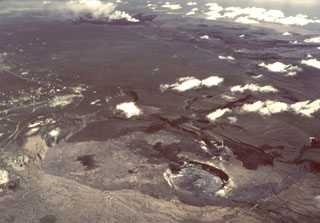Report on Kilauea (United States) — 1 February-7 February 2017
Smithsonian Institution / US Geological Survey
Weekly Volcanic Activity Report, 1 February-7 February 2017
Managing Editor: Sally Sennert.
Please cite this report as:
Global Volcanism Program, 2017. Report on Kilauea (United States) (Sennert, S, ed.). Weekly Volcanic Activity Report, 1 February-7 February 2017. Smithsonian Institution and US Geological Survey.
Kilauea
United States
19.421°N, 155.287°W; summit elev. 1222 m
All times are local (unless otherwise noted)
During 1-7 February HVO reported that the lava lake continued to rise and fall, circulate, and spatter in Kilauea’s Overlook vent. Webcams recorded incandescence from long-active sources within Pu'u 'O'o Crater and from a vent high on the NE flank of the cone. The 61G lava flow, originating from a vent on Pu'u 'O'o Crater's E flank, continued to enter the ocean at Kamokuna. All surface flows were active within 2.4 km of Pu'u 'O'o.
HVO geologists noted an extensive crack running parallel to the sea cliff about 5-10 m behind the stream of lava entering the ocean at Kamokuna. The crack was 30 cm wide on 28 January and 70 cm wide four days later, on 1 February. In addition, the seaward block bounded by this crack was visibly moving up to 1 cm, and ground shaking could be felt up to several hundred meters away. On 2 February the crack was wider and steaming, and the stream of lava that had been pouring into the ocean from an opening in a lava tube about 20 m above the water was no longer visible (though lava continued to enter the ocean). At about 1255 almost the entire section of the sea cliff that was seaward of the hot crack collapsed. The collapsed block generated a wave that propagated outward from the coast. After the collapse, no lava was visible entering the ocean though a steam plume and spatter from explosions indicated that the entry remained active.
Geological Summary. Kilauea overlaps the E flank of the massive Mauna Loa shield volcano in the island of Hawaii. Eruptions are prominent in Polynesian legends; written documentation since 1820 records frequent summit and flank lava flow eruptions interspersed with periods of long-term lava lake activity at Halemaumau crater in the summit caldera until 1924. The 3 x 5 km caldera was formed in several stages about 1,500 years ago and during the 18th century; eruptions have also originated from the lengthy East and Southwest rift zones, which extend to the ocean in both directions. About 90% of the surface of the basaltic shield volcano is formed of lava flows less than about 1,100 years old; 70% of the surface is younger than 600 years. The long-term eruption from the East rift zone between 1983 and 2018 produced lava flows covering more than 100 km2, destroyed hundreds of houses, and added new coastline.
Source: US Geological Survey Hawaiian Volcano Observatory (HVO)

